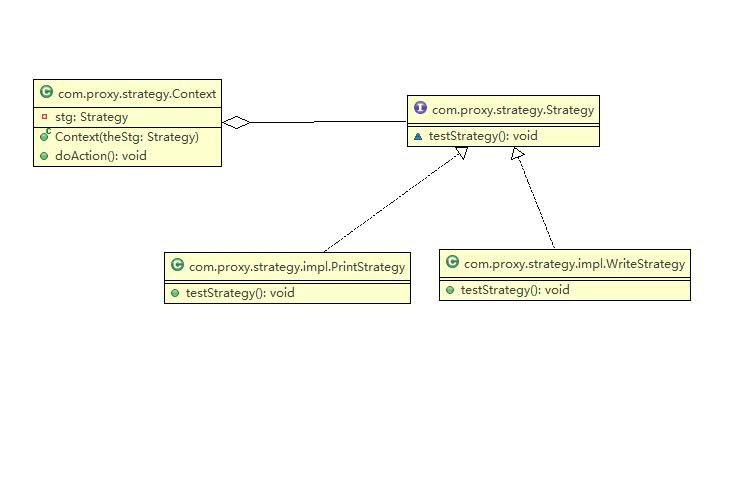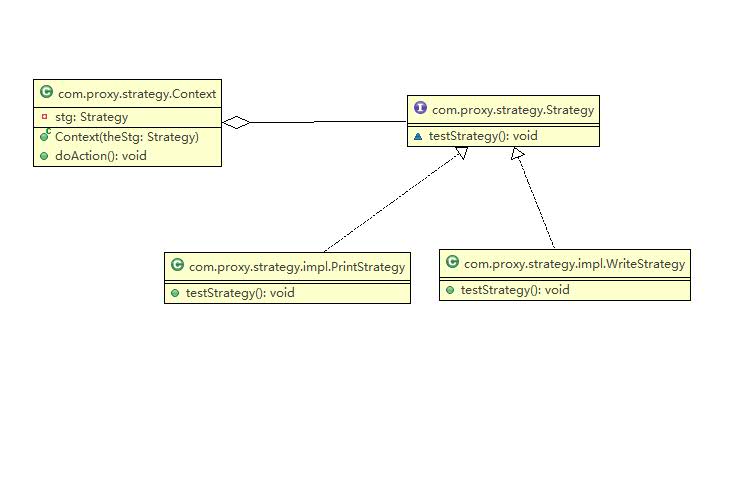Spring and Strategy Pattern
1: Definition of Strategy Pattern
The strategy pattern is a packaging of the algorithm, which separates the responsibility of using the algorithm from the algorithm itself and delegates it to different object management. The strategy pattern usually packages a series of algorithms into a series of strategy classes, as a subclass of an abstract strategy class.
The class diagram is as follows:

If the strategy pattern is to be implemented using JAVA classes, the source code is as follows:
Java code
/**
*
* 策略执行
* @author weique.lqf
* @version $Id: Context.java, v 0.1 2014-2-9 下午2:32:56 weique.lqf Exp $
*/
public class Context {
private Strategy stg;
public Context(Strategy theStg) {
this.stg = theStg;
}
public void doAction() {
this.stg.testStrategy();
}
}Strategy interface:
Java代码
/**
*
*
* @author weique.lqf
* @version $Id: Strategy.java, v 0.1 2014-2-9 下午2:32:17 weique.lqf Exp $
*/
public interface Strategy {
void testStrategy();
}Implementation class one :
Java code
package com.proxy.strategy.impl;
import com.proxy.strategy.Strategy;
public class PrintStrategy implements Strategy {
public void testStrategy() {
System.out.print("我要打印!!");
}
}Implementation category two:
Java code
package com.proxy.strategy.impl;
import com.proxy.strategy.Strategy;
public class WriteStrategy implements Strategy {
public void testStrategy() {
System.out.println("我要写字!!!");
}
}Execution code:
Java code
package com.proxy.strategy;
import com.proxy.strategy.impl.PrintStrategy;
public class StrategyClient {
public static void main(String[] args) {
Strategy stgA = new PrintStrategy();
Context ct = new Context(stgA);
ct.doAction();
}
}Two: spring implementation strategy pattern
Now The system using spring can There are so many, so how to implement strategies in spring mode?
In fact, it only needs a little modification, because one of the cores of spring is IOC.
First modify the Contex class:
Java code
package com.proxy.strategy;
public class ContextSpring {
private Strategy stg;
/**
* Setter method for property <tt>stg</tt>.
*
* @param stg value to be assigned to property stg
*/
public void setStg(Strategy stg) {
this.stg = stg;
}
public void doAction() {
this.stg.testStrategy();
}
}Then configure it in the spring configuration file,
Xml code
<bean id="ct" class = "com.proxy.strategy.ContextSpring">
<property name="stg" ref="writeStg"/>
</bean>
<bean id="writeStg" class = "com.proxy.strategy.impl.WriteStrategy"/>
<bean id="printStg" class = "com.proxy.strategy.impl.PrintStrategy"/>Select the implementation class you want to inject, and then write this in the executed code :
Java code
package com.proxy.strategy;
import org.springframework.context.ApplicationContext;
import org.springframework.context.support.ClassPathXmlApplicationContext;
public class StrategySpringClient {
public static void main(String[] args) {
ApplicationContext context = new ClassPathXmlApplicationContext("Beans.xml");
ContextSpring ct = (ContextSpring) context.getBean("ct");
ct.doAction();
}
}Look, spring is introduced in this way.
But this has advantages and disadvantages. If I want to apply according to different types, for example: contracts need to be printed, while love letters need to be handwritten. Assuming that the contract is type 2 and the love letter is type 1, how do we automatically adapt?
Three: Advanced version of spring strategy mode
First modify the Context class:
Java code
package com.proxy.strategy;
import java.util.HashMap;
import java.util.Map;
/**
*
*
* @author weique.lqf
* @version $Id: ContextSpringFactory.java, v 0.1 2014-2-9 下午3:46:09 weique.lqf Exp $
*/
public class ContextSpringFactory {
private Map<String, Strategy> stgMap = new HashMap<String, Strategy>();
/**
* Getter method for property <tt>stgMap</tt>.
*
* @return property value of stgMap
*/
public Map<String, Strategy> getStgMap() {
return stgMap;
}
/**
* Setter method for property <tt>stgMap</tt>.
*
* @param stgMap value to be assigned to property stgMap
*/
public void setStgMap(Map<String, Strategy> stgMap) {
this.stgMap = stgMap;
}
public void doAction(String strType) {
this.stgMap.get(strType).testStrategy();
}
}Then modify the spring configuration file:
Xml code
<bean id="ctf" class = "com.proxy.strategy.ContextSpringFactory">
<property name="stgMap">
<map>
<entry key="1" value-ref="writeStg"/>
<entry key="2" value-ref="printStg"/>
</map>
</property>
</bean>The entry class modification performed For:
Java code
package com.proxy.strategy;
import org.springframework.context.ApplicationContext;
import org.springframework.context.support.ClassPathXmlApplicationContext;
public class StrategySpringClientFactory {
public static void main(String[] args) {
//外部参数
String type = "1";
ApplicationContext context = new ClassPathXmlApplicationContext("Beans.xml");
ContextSpringFactory ctf = (ContextSpringFactory) context.getBean("ctf");
ctf.doAction(type);
//type 2
type = "2";
ctf.doAction(type);
}
}Then run it and see what the results will be?


Hot AI Tools

Undresser.AI Undress
AI-powered app for creating realistic nude photos

AI Clothes Remover
Online AI tool for removing clothes from photos.

Undress AI Tool
Undress images for free

Clothoff.io
AI clothes remover

Video Face Swap
Swap faces in any video effortlessly with our completely free AI face swap tool!

Hot Article

Hot Tools

Notepad++7.3.1
Easy-to-use and free code editor

SublimeText3 Chinese version
Chinese version, very easy to use

Zend Studio 13.0.1
Powerful PHP integrated development environment

Dreamweaver CS6
Visual web development tools

SublimeText3 Mac version
God-level code editing software (SublimeText3)

Hot Topics
 1387
1387
 52
52
 A new programming paradigm, when Spring Boot meets OpenAI
Feb 01, 2024 pm 09:18 PM
A new programming paradigm, when Spring Boot meets OpenAI
Feb 01, 2024 pm 09:18 PM
In 2023, AI technology has become a hot topic and has a huge impact on various industries, especially in the programming field. People are increasingly aware of the importance of AI technology, and the Spring community is no exception. With the continuous advancement of GenAI (General Artificial Intelligence) technology, it has become crucial and urgent to simplify the creation of applications with AI functions. Against this background, "SpringAI" emerged, aiming to simplify the process of developing AI functional applications, making it simple and intuitive and avoiding unnecessary complexity. Through "SpringAI", developers can more easily build applications with AI functions, making them easier to use and operate.
 Use Spring Boot and Spring AI to build generative artificial intelligence applications
Apr 28, 2024 am 11:46 AM
Use Spring Boot and Spring AI to build generative artificial intelligence applications
Apr 28, 2024 am 11:46 AM
As an industry leader, Spring+AI provides leading solutions for various industries through its powerful, flexible API and advanced functions. In this topic, we will delve into the application examples of Spring+AI in various fields. Each case will show how Spring+AI meets specific needs, achieves goals, and extends these LESSONSLEARNED to a wider range of applications. I hope this topic can inspire you to understand and utilize the infinite possibilities of Spring+AI more deeply. The Spring framework has a history of more than 20 years in the field of software development, and it has been 10 years since the Spring Boot 1.0 version was released. Now, no one can dispute that Spring
 What are the implementation methods of spring programmatic transactions?
Jan 08, 2024 am 10:23 AM
What are the implementation methods of spring programmatic transactions?
Jan 08, 2024 am 10:23 AM
How to implement spring programmatic transactions: 1. Use TransactionTemplate; 2. Use TransactionCallback and TransactionCallbackWithoutResult; 3. Use Transactional annotations; 4. Use TransactionTemplate in combination with @Transactional; 5. Customize the transaction manager.
 How to implement scheduled tasks in Java Spring
May 24, 2023 pm 01:28 PM
How to implement scheduled tasks in Java Spring
May 24, 2023 pm 01:28 PM
Java implements scheduled tasks In the library that comes with Jdk, there are two ways to implement scheduled tasks, one is Timer, and the other is ScheduledThreadPoolExecutor. When Timer+TimerTask creates a Timer, it creates a thread, which can be used to schedule TimerTask tasks. Timer has four construction methods, and you can specify the name of the Timer thread and whether to set it as a daemon thread. The default name is Timer-number, and the default is not a daemon thread. There are three main methods: cancel(): terminate task scheduling, cancel all currently scheduled tasks, running tasks will not be affected purge(): remove tasks from the task queue
 The differences and connections between Spring Boot and Spring Cloud
Jun 22, 2023 pm 06:25 PM
The differences and connections between Spring Boot and Spring Cloud
Jun 22, 2023 pm 06:25 PM
SpringBoot and SpringCloud are both extensions of Spring Framework that help developers build and deploy microservice applications faster, but they each have different purposes and functions. SpringBoot is a framework for quickly building Java applications, allowing developers to create and deploy Spring-based applications faster. It provides a simple, easy-to-understand way to build stand-alone, executable Spring applications
 The 7 most commonly used annotations in Spring, the most powerful organization in history!
Jul 26, 2023 pm 04:38 PM
The 7 most commonly used annotations in Spring, the most powerful organization in history!
Jul 26, 2023 pm 04:38 PM
With the update and iteration of technology, Java5.0 began to support annotations. As the leading framework in Java, spring has slowly begun to abandon xml configuration since it was updated to version 2.5, and more annotations are used to control the spring framework.
 How to set transaction isolation level in Spring
Jan 26, 2024 pm 05:38 PM
How to set transaction isolation level in Spring
Jan 26, 2024 pm 05:38 PM
How to set the transaction isolation level in Spring: 1. Use the @Transactional annotation; 2. Set it in the Spring configuration file; 3. Use PlatformTransactionManager; 4. Set it in the Java configuration class. Detailed introduction: 1. Use the @Transactional annotation, add the @Transactional annotation to the class or method that requires transaction management, and set the isolation level in the attribute; 2. In the Spring configuration file, etc.
 Learn Spring Cloud from scratch
Jun 22, 2023 am 08:11 AM
Learn Spring Cloud from scratch
Jun 22, 2023 am 08:11 AM
As a Java developer, learning and using the Spring framework is an essential skill. With the popularity of cloud computing and microservices, learning and using Spring Cloud has become another skill that must be mastered. SpringCloud is a development toolset based on SpringBoot for quickly building distributed systems. It provides developers with a series of components, including service registration and discovery, configuration center, load balancing and circuit breakers, etc., allowing developers to build micro




